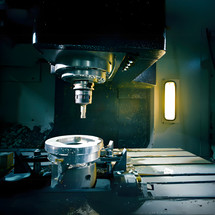16th Apr 2025
Machine Tools for Woodworking vs. Metalworking: Key Differences
Whether you’re entering the field as a hobbyist or professional, woodworking and metalworking are among the first things that you’ll learn.
Although every field of work depends on accuracy, different tools differ significantly in design, durability, usefulness, and safety issues. Selecting appropriate tools for your tasks guarantees the best results, depending on an awareness of these variations.
Therefore, this guide will examine the different aspects of woodworking and metalworking, from their build and cutting requirements to speed, functionality, and maintenance demands.
Continue reading as we learn more about the fundamental differences between the tools in the following sections.
Machine Tools for Woodworking vs. Metalworking
1. Material Properties and Tool Design
The nature of the materials stands out as the standard difference between metal and woodworking tools. Woodworking tools are generally soft, lightweight, and fibrous, whereas metal tools are more durable, strong, and long-lasting.
Woodworking Tools:
Designed for softer materials, woodworking tools are designed for quick action. They generally have high-velocity blades. Some of the most common types of tools include circular saws, band saws, planers, joiners, and routers. They’re best used for shaping, smoothing, and detailing wood.
Metalworking Tools:
When working machines used in metalworking industries with metalworking tools, expect extreme pressure. These tools are built utilizing heavy-duty components and are generally used in creating milling machines, drill presses, lathes, and grinders. These instruments can readily cut through heavy metals and are quite resistant to high heat and wear.
Key Takeaway
Woodworking tools are designed for speed and accuracy, while metalworking tools perform under extreme conditions.
2. Cutting Speeds and Feeds
Cutting speeds and feeds are another crucial aspect of machine tools. They differ significantly for metal and woodworking tools. Let’s learn more about them here:
Woodworking:
Woodworking tools have a high cutting rate without giving in to excessive heat generation. They are best for creating neat, crisp cuts, and tools like routers and circular saws spin fast, generating up to 20,000 RPM.
Metalworking:
Slower cutting rates in metalworking tools help prevent tool wear and overheating. These machines use metals, and the blade runs at 50–1,000 RPM. Additionally, they’re exposed to high heat, which must be dissipated using proper lubrication and cooling fluids or cutting oils.
Key Takeaway
You can experience tool failure if you use woodworking tools on metal items. On the contrary, when using a metalwork tool on wooden artifacts, it might burn the substance.
3. Precision and Tolerances
Precision and tolerance are other crucial aspects of comparing wood and metalworking tools. Both tools have different levels of tolerance. Let’s learn more about it here:
Woodworking
While accuracy is essential, wood naturally expands and shrinks with temperature and humidity variations. For most furniture, cabinets, and ornamental work, woodworking tolerances are usually about ±0.5mm, which is reasonable.
Metalworking
Metalworking tools, particularly those used in sectors like aerospace, automotive, and medical devices, require high tolerance levels, sometimes within ±0.001mm. This is a primary reason why metalworking tools are designed with a more robust structure to satisfy these strict criteria while using calibrated controls.
Key Takeaway
Many woodworkers who transition into metalworking are surprised by the meticulous attention to precision required in metal fabrication.
4. Tooling and Cutting Materials
Both metal and woodworking tools have different design languages. They have different cutting edges, designed for other materials to fit their intended use.
Woodworking:
These tools are often designed using carbide-tipped blades or high-speed steel (HSS). The use of such blades and materials ensures longevity and increases operating hours.
Metalworking:
Tools used in metalworking call for tougher, more wear-resistant materials. These tools include carbide, cobalt alloys, and ceramics. The use of such materials ensures they resist the heat of harder metals like steel, aluminum, or titanium without generating friction or heat damage.
Key Takeaway
Woodworking tools have high-speed blades to ensure extended operations. Metalworking tools often have replaceable blades to extend the life of the tool and allow easy maintenance.
5. Workholding Techniques
Next, we have the workholding techniques that make a difference in your work experience. Let’s learn more about it in this section:
Woodworking
Woodworking tools might depend on simpler clamping systems, vises, and fences for efficient operations. This is mainly because they require less force to maintain the stability of the material, as wood is light and slices readily.
Metalworking
Unlike woodworking tools, metalworking equipment is fastened tightly to prevent movement and vibration. This is mostly due to metals' density and resistance. Heavy-duty vises, magnetic chucks, and specialized fixtures are common tools that guarantee exact, steady machining.
Conclusion: Which Should You Choose?
Choosing the right set of machinery tools depends on your work and project objectives. Woodworking tools are a great option because they are quick and adaptable, making them ideal for building cabinets, furniture, or wooden artwork. However, metalworking tools are essential for getting precise results when it comes to accuracy and strength.
Eventually, many experts decide to learn to use both tools to enhance their skills. Investing in excellent tools from reputable vendors such as Penn Tool Co. guarantees you will have dependable equipment built to handle your selected materials, regardless of the route you choose, thereby enabling you to accomplish professional results every time.
Remember, every field presents different opportunities and problems; the first step in developing your trade is knowing their different toolsets.

